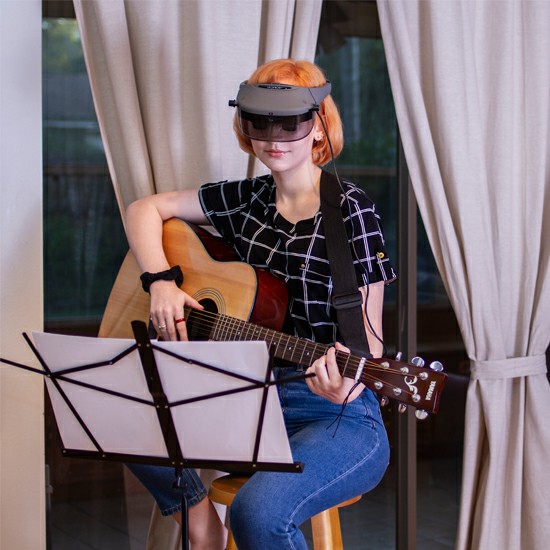You might be familiar with the concept of low vision aids if you have vision loss or your loved ones are visually impaired. It’s a general variety that contains various types of low vision products or digital assistive devices that can help low vision people live independently. From slight to severe eyesight loss, you can always find one that fits your own situation, and this is why low vision aids are vital for people with visual impairments.
Definition of Low Vision Aids
Low vision aids cover a wide range of tools, gadgets, and technologies that can help people with low vision or other visual impairments see better and carry out daily tasks. Individuals with eye disorders like macular degeneration (AMD), glaucoma, or other visual impairments that cannot be totally corrected with medical interventions, eyeglasses, or contact lenses should use low vision devices to maximize their residual vision.
 Another concept that is highly relevant to the visually impaired and sometimes overlaps with low vision aids is the assistive technology for people with vision loss. It refers to an even broader range of technology that can provide help and convenience for people with visual impairments in their daily life. Besides low vision aids, now the common assistive technology for people with low vision on the market includes, for instance, screen reading software, optical character recognition (OCR) apps, mobile apps, voice-activated assistants, and so on. Many low vision aids are designed based on these assistive technologies, and this is how crucial the development of technology is to the promotion of low vision people’s life.
Another concept that is highly relevant to the visually impaired and sometimes overlaps with low vision aids is the assistive technology for people with vision loss. It refers to an even broader range of technology that can provide help and convenience for people with visual impairments in their daily life. Besides low vision aids, now the common assistive technology for people with low vision on the market includes, for instance, screen reading software, optical character recognition (OCR) apps, mobile apps, voice-activated assistants, and so on. Many low vision aids are designed based on these assistive technologies, and this is how crucial the development of technology is to the promotion of low vision people’s life.
While the good news is that low vision aids contain several types and different forms, so they can always fit whether severe vision loss or partially losing eyesight. They not only work with the usual eye diseases like AMD, cataracts, glaucoma, diabetic retinopathy, and retinitis pigmentosa (RP), the individuals with congenital abnormalities, retinal detachments, albinism, optic nerve atrophy, or severe eye injuries might also benefit from low vision aids.
Common Types of Low Vision Aids
Generally speaking, the most common types of low vision aids known by people are 3 types: optical, non-optical, and electronic magnifiers. Of course there are some other types like color identifiers, talking compasses, walking sticks, and so on, which may be less selected, as they more work for people with related needs and not as inclusive as the 3 types mentioned above.
Optical
 Low vision aids with optical qualities capable of fostering higher visual performance through lenses are recommended when traditional lenses are unable to give the requisite visual range. Usually, the optical visual aids can help with distance view or near view. The optical device for distance view usually refers to the telescope, and the most well-known species are the Galilean telescope and the Keplerian telescope. Each of these two telescopes has its own advantages and disadvantages due to their different principals. When planning to buy anyone of them, it is good for you to search on the web for more details and make sure which one suits your need.
Low vision aids with optical qualities capable of fostering higher visual performance through lenses are recommended when traditional lenses are unable to give the requisite visual range. Usually, the optical visual aids can help with distance view or near view. The optical device for distance view usually refers to the telescope, and the most well-known species are the Galilean telescope and the Keplerian telescope. Each of these two telescopes has its own advantages and disadvantages due to their different principals. When planning to buy anyone of them, it is good for you to search on the web for more details and make sure which one suits your need.
 Optical aids for near view mainly include magnifying spectacles, handheld magnifiers, and stand magnifiers. Magnifying spectacles may allow a wider field of view (FOV) and hands-free use, but on the other hand, may also exist a shortage like not suitable for an eccentric fixation. While handheld magnifiers often seem to be useful for most people because they’re really easy to use. However, the FOV is limited and it requests one hand occupied. Similarly, the stand magnifiers are made to be put directly on the object or piece of reading material. For extended reading sessions, stand magnifiers are frequently favored but for comfortable reading, a flat surface is always required.
Optical aids for near view mainly include magnifying spectacles, handheld magnifiers, and stand magnifiers. Magnifying spectacles may allow a wider field of view (FOV) and hands-free use, but on the other hand, may also exist a shortage like not suitable for an eccentric fixation. While handheld magnifiers often seem to be useful for most people because they’re really easy to use. However, the FOV is limited and it requests one hand occupied. Similarly, the stand magnifiers are made to be put directly on the object or piece of reading material. For extended reading sessions, stand magnifiers are frequently favored but for comfortable reading, a flat surface is always required.
Optical low vision aids are usually popular by their portability and ease of use, requiring minimal learning. They are more affordable compared to other electronic devices. However, optical aids have inherent limitations as well. For instance, texts may appear distorted through the optical visual aids, resulting in a poor reading experience for the eyes. Moreover, they offer a fixed magnification and require adjustment of distance for magnification adjustment. And the image quality may not be ideal, especially for stand magnifiers. Additionally, using optical visual aids, you wouldn’t have reading lines or color contrast setting, which makes it challenging to track reading targets and unfriendly for individuals with color vision deficiencies or severe visual impairments.
Non-optical
Low vision assistance equipment without lenses or optics is explained as non-optical low vision aids. To improve the visual perception or access information, these devices rely on other sensory modalities or alternative techniques. Here are some examples of non-optical low vision aids:
- Modifications to the lighting: For people with low vision, good lighting is essential for maximizing visual perception. Visibility can be increased and glare can be decreased with brighter, more focused lighting.
- Tactile Aids: Tactile aids help people with impaired vision acquire information by using raised or textured surfaces like braille labels, tactile markings on gadgets, and tactile maps to provide sensory input.
- Auditory Aids: Audiobooks, talking watches and clocks, and voice-guided navigation systems communicate information through voice or sound output. They can make it easier for those with limited vision to acquire information that normally relies on visual clues.
- Enhancers for color and contrast: Color filters, tinted glasses or overlays, and highly contrasted materials or signage are noticed to help people with low vision better perceive color and contrast, and it can be more complicated than the above-mentioned ways.
Actually, there are more representatives for non-optical low vision aids. Electronic assistive devices, including electronic magnifiers, software applications on smartphones or tablets, screen readers and other devices are also a part of non-optical visual aids. And the electronic magnifiers will be particularly introduced in the following section as they’re another well-known type for low vision aids.

Electronic magnifiers
There is no doubt that electronic magnifiers also belong to the scope of low vision aids, they can always satisfy the users and provide optimal convenience and portability. People also call them electronic magnifying aids, digital magnifiers or electronic visual aids. Compared to optical magnifiers, electronic magnifiers possess more advanced functions like a wider range of magnification options, additional features, and flexibility in adjusting contrast and color. Next, we’ll specifically discuss the superiority of electronic magnifiers.
 The electronic magnifiers integrate optical and electrical elements to provide cutting-edge features and customization choices. There are also several performances in a variety of electronic magnifiers like electronic video magnifiers, closed-circuit television (CCTV) systems, the wearable devices and so on. These electronic low vision devices provide a variety of features and functionalities to improve visual access and independence. The most appropriate electronic aid is chosen based on the individual’s visual requirements, preferences, and the particular tasks they want to carry out.
The electronic magnifiers integrate optical and electrical elements to provide cutting-edge features and customization choices. There are also several performances in a variety of electronic magnifiers like electronic video magnifiers, closed-circuit television (CCTV) systems, the wearable devices and so on. These electronic low vision devices provide a variety of features and functionalities to improve visual access and independence. The most appropriate electronic aid is chosen based on the individual’s visual requirements, preferences, and the particular tasks they want to carry out.
Take the product of Zoomax as an example, Zoomax is dedicated in providing low vision aids including electronic video magnifiers and wearable E-glasses to make contributions to the promotion of visually impaired people’s life quality. In a more detailed way, Zoomax holds multiple types of low vision aids so that people can choose for their specific use like outdoors, everyday utilization, study, work, travel, etc. Each electronic low vision device contains different features and functions, and they can usually play a more comprehensive role in the life of low vision people.
How Low Vision Aids Help People with Vision Loss
With the use of low vision devices, visually impaired people can continue to be independent in their daily lives. Magnifiers, contrast-enhancing equipment, and assistive technologies, among other things, let people read, write, cook, and perform other necessary chores without severely depending on others. The participation in their daily activities can also boost self-esteem and overall well-being. Meanwhile, people who use low vision aids can read books, or communications, access digital content, and use social media or other online communication tools, which improves their capacity to interact with people, pursue interests, and maintain relationships with friends and family.
The importance of low vision aids for people with vision loss cannot be fully summarized here. However, it is being proven that low vision aids realize more convenience, provide daily help and bring joy and happiness to those who feel down with eyesight loss. Thus, the low vision aids eventually positively impact the mental health of the visually impaired individuals.

Employment and education opportunities for people with vision impairments sometimes can even be improved by using the low vision aids and with the help of low vision supportive organizations. To some extent, this is not only the progress of visually impaired individuals but also the improvement of the entire society. By providing access to information, enabling participation in activities, and fostering independence, low vision aids are empowering individuals to live more fulfilling, active, and engaged lives. This can be the deep meaning of low vision aids.

